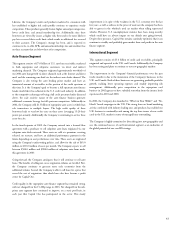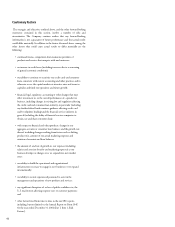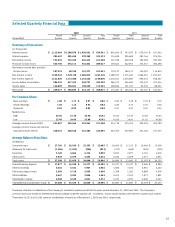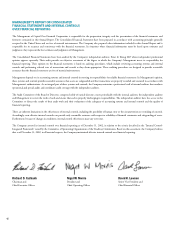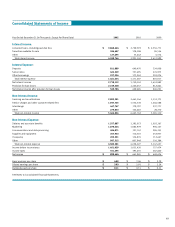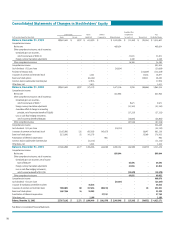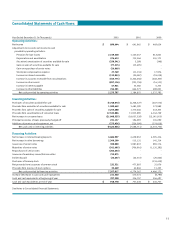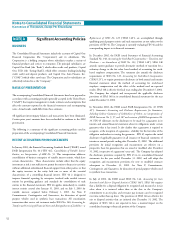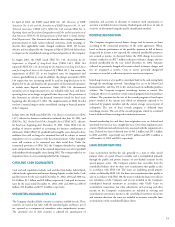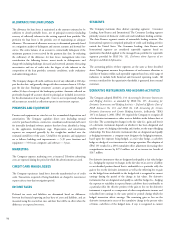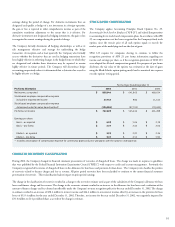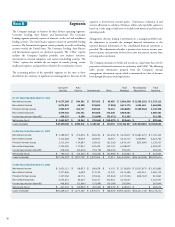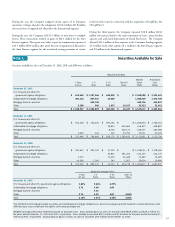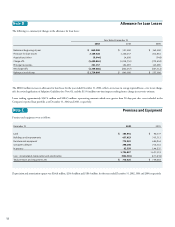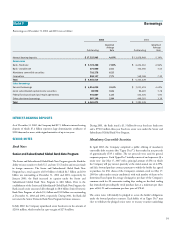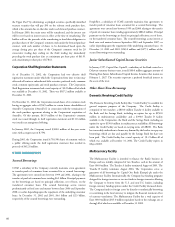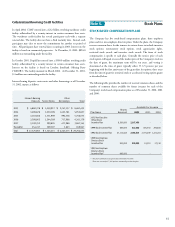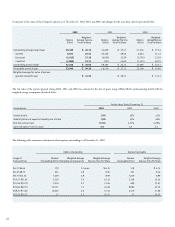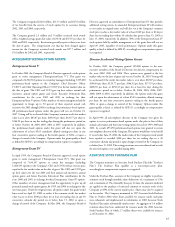Capital One 2002 Annual Report Download - page 55
Download and view the complete annual report
Please find page 55 of the 2002 Capital One annual report below. You can navigate through the pages in the report by either clicking on the pages listed below, or by using the keyword search tool below to find specific information within the annual report.
53
premiums and accretion of discounts to maturity. Such amortization or
accretion is included in interest income. Realized gains and losses on sales of
securities are determined using the specific identification method.
REVENUE RECOGNITION
The Company recognizes earned finance charges and fee income on loans
according to the contractual provisions of the credit agreements. When,
based on historic performance of the portfolio, payment in full of finance
charge and fee income is not expected, the estimated uncollectible portion is
not accrued as income. As discussed below, the 2002 change in recoveries
estimate resulted in an $82.7 million reduction of finance charges and fees
deemed uncollectible for the year ended December 31, 2002. Amounts
collected on previously charged-off accounts related to finance charges and
fees are recognized as income. Costs to recover previously charged-off
accounts are recorded as collection expense in non-interest expenses.
Interchange income is a fee paid by a merchant bank to the card-issuing bank
through the interchange network. Interchange fees are set by MasterCard
International Inc. and Visa U.S.A. Inc. and are based on cardholder purchase
volumes. The Company recognizes interchange income as earned. The
Company offers to its customers certain rewards programs based on purchase
volumes. The provision for the cost of the rewards programs is based upon
points awarded in the current year which are ultimately expected to be
redeemed by program members and the current average cost per point of
redemption. The cost of these rewards programs is deducted from
interchange income. The cost of the rewards programs related to securitized
loans is deducted from servicing and securitizations income.
Annual membership fees and direct loan origination costs are deferred and
amortized over one year on a straight-line basis. Direct loan origination costs
consist of both internal and external costs associated with the origination of a
loan. Deferred fees (net of deferred costs of $45.2 million and $55.1 million
in 2002 and 2001, respectively) were $325.9 million and $291.6 million as
of December 31, 2002 and 2001, respectively.
LOAN SECURITIZATIONS
Loan securitization involves the sale, generally to a trust or other special
purpose entity, of a pool of loan receivables and is accomplished primarily
through the public and private issuance of asset-backed securities by the
special purpose entity. The Company removes loan receivables from the
consolidated balance sheet for those asset securitizations that qualify as sales
in accordance with SFAS 140. The trusts are qualifying special purpose
entities as defined by SFAS 140. For those asset securitizations that qualify as
sales in accordance with SFAS 140, the trusts to which the loans were sold are
not subsidiaries of the Company, and are not included in the Company’s
consolidated financial statements in accordance with GAAP. Gains on
securitization transactions, fair value adjustments and servicing and other
income on the Company’s securitizations are included in servicing and
securitizations non-interest income in the consolidated statements of income
and amounts due from the trusts are included in accounts receivable from
securitizations on the consolidated balance sheets.
In April of 2002, the FASB issued SFAS No. 145, Rescission of FASB
Statements No. 4, 44, and 64, Amendment of FASB Statement No. 13, and
Technical Corrections (“SFAS 145”). SFAS No. 145 rescinds SFAS No. 4,
Reporting Gains and Losses from Extinguishment of Debt, and an amendment of
that Statement, SFAS No. 64, Extinguishments of Debt Made to Satisfy Sinking-
Fund Requirements. This Statement also amends other existing authoritative
pronouncements to make various technical corrections, clarify meanings, or
describe their applicability under changed conditions. SFAS 145 became
effective and was adopted by the Company in May of 2002 and did not have
an impact on the consolidated earnings or financial position of the Company.
In August 2001, the FASB issued SFAS No. 144, Accounting for the
Impairment or Disposal of Long-Lived Assets (“SFAS 144”). SFAS 144
supersedes SFAS No. 121, Accounting for the Impairment of Long-Lived Assets
and for Long-Lived Assets to Be Disposed Of (“SFAS 121”), but retains the
requirements of SFAS 121 to test long-lived assets for impairment and
removes goodwill from its scope. In addition, the changes presented in SFAS
144 require that one accounting model be used for long-lived assets to be
disposed of by sale and broadens the presentation of discontinued operations
to include more disposal transactions. Under SFAS 144, discontinued
operations are no longer measured on a net realizable value basis, and future
operating losses are no longer recognized before they occur. The provisions of
this Statement are effective for financial statements issued for fiscal years
beginning after December 15, 2001. The implementation of SFAS 144 did
not have a material impact on the consolidated earnings or financial position
of the Company.
In June 2001, the FASB issued SFAS No. 141, Business Combinations (“SFAS
141”), effective for business combinations initiated after June 30, 2001, and
SFAS No. 142, Goodwill and Other Intangible Assets (“SFAS 142”), effective
for fiscal years beginning after December 15, 2001. Under SFAS 141, the
pooling of interests method of accounting for business combinations is
eliminated. Under SFAS 142, goodwill and intangible assets deemed to have
indefinite lives will no longer be amortized but will be subject to annual
impairment tests in accordance with the pronouncement. Other intangible
assets will continue to be amortized over their useful lives. Under the
transitional provisions of SFAS 142, the Company identified its reporting
units and performed the first of the required impairment tests of net goodwill
and indefinite-lived intangible assets during 2002. The testing resulted in no
impairment losses to any recorded goodwill of the Company.
CASH AND CASH EQUIVALENTS
Cash and cash equivalents includes cash and due from banks, federal funds
sold and resale agreements and interest-bearing deposits at other banks. Cash
paid for interest for the years ended December 31, 2002, 2001 and 2000 was
$1.4 billion, $1.1 billion and $.8 billion, respectively. Cash paid for income
taxes for the years ended December 31, 2002, 2001 and 2000 was $585.8
million, $70.8 million and $237.2 million, respectively.
SECURITIES AVAILABLE FOR SALE
The Company classifies all debt securities as securities available for sale. These
securities are stated at fair value, with the unrealized gains and losses, net of
tax, reported as a component of cumulative other comprehensive income.
The amortized cost of debt securities is adjusted for amortization of


